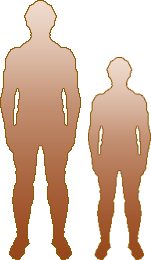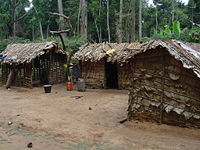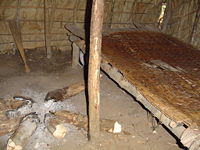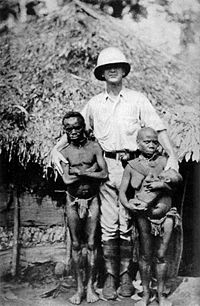Difference between revisions of "Pygmy" - New World Encyclopedia
From New World Encyclopedia
(copied from Wikipedia) |
(→Mbuti) |
||
| Line 54: | Line 54: | ||
The '''Mbuti''' are one of several [[Indigenous peoples of Africa|indigenous]] [[hunter-gatherer]] groups in the [[Congo]] region of [[Africa]]. | The '''Mbuti''' are one of several [[Indigenous peoples of Africa|indigenous]] [[hunter-gatherer]] groups in the [[Congo]] region of [[Africa]]. | ||
| + | Of the [[Pygmies]], Batwa, or [[Bushmen]], the Mbuti is one such group of [[hunter-gatherer]]s. One of the oldest inhabitants of the area, the Mbuti are composed of bands which are relatively small in size, ranging from 15 to 60 people. The Mbuti population totals about 30,000 to 40,000 people. There are three distinct [[culture]]s, each with their own [[dialect]], within the Mbuti. These are the Efe, which speak Balese, the Sua, who speak Bira, and the Aka who speak Mangbetu <ref name=Mukenge> <ref>Mukenge, Tshilemalea. 2002. ''Culture and Customs of the Congo'' Westport, CT:Greenwood Press </ref>. | ||
| + | The [[Ancient Egypt]]ians, around 2,500 B.C.E. made reference to a "people of the [[tree|trees]]" that could be the Mbuti. <ref name=Turnbull> <ref>Turnbull, Colin M. 1968. ''The Forest People''. New York, NY: Simon and Schuster, Inc.</ref> | ||
| − | + | The Mbuti live in the [[forest|forested]] [[Congo]] region, located in the heart of [[Africa]]. The country is now called The [[Democratic Republic of Congo]]. Specifically, they sustain themselves by hunting and gathering in the [[Ituri]] forest, in northeast [[Zaire]] <ref name=Mukenge> <ref>Mukenge, Tshilemalea. 2002. ''Culture and Customs of the Congo'' Westport, CT:Greenwood Press </ref>. The Mbuti escape many influences and pressures from the national [[government]] by living a traditional way of life in the forest. [[Civil war]] and violation of [[human rights]] has affected the lives of many of the Mbuti. Some of the [[hunter-gatherer|hunter-gatherers]] choose to move into modern day villages instead of retaining the customary Mbuti life, due to pressure from the [[government]]. If there are disputes or wrongdoing from an individual, the Mbuti usually take matters into their own hands by either banishing, beating, or in smaller incidences, ridicule <ref name=Mukenge> <ref>Mukenge, Tshilemalea. 2002. ''Culture and Customs of the Congo'' Westport, CT:Greenwood Press </ref>. | |
| − | The [[ | + | The forest of [[Ituri]] is a tropical [[rain forest]]. In this area, there is a high amount of rainfall annually, ranging from 50 to 70 inches <ref name=Ehret> <ref>Ehret, Christopher. 1998. ''The Civilizations of Africa'' Charlottesville, VA: University Press of Virginia.</ref> The [[rainforest]] is 70,000 square kilometers. The [[dry season]] is relatively short, ranging from one to two months in duration <ref name=Ehret> Ehret, Christopher. 1998. ''The Civilizations of Africa'' Charlottesville, VA: University Press of Virginia.</ref>. The forest is a moist, humid region strewn with [[river|rivers]] and [[lake|lakes]]. Several ecological problems exist that affect the Mbuti. [[Disease]] is prevalent in the forests and can spread quickly, not only killing humans, but plants, and animals, the major source of food, as well. One disease, carried by [[tsetse flies]], is [[sleeping sickness]], which limits the use of large [[mammals]] <ref name=King> King, Glenn. 2002. ''Traditional Cultures''. Prospect Heights, IL: Waveland Press. Too much rainfall and [[drought|droughts]] can greatly diminish the food supply as well. |
| + | The Mbuti live in villages that consist are categorized as bands. Each [[hut]] houses a [[family]] unit. At the start of the [[dry season]], they leave the village to enter the forest and set up a series of camps <ref name=King> King, Glenn. 2002. ''Traditional Cultures''. Prospect Heights, IL: Waveland Press. This way the Mbuti are able to utilize more land area for maximum [[foraging]]. These villages are solitary and separated from other groups of people. Their houses are small, circular, and very temporary. Unlike many modern architects, they do not use [[blueprint|blueprints]], but instead trace the outline of the house into the ground <ref name=Mukenge> Mukenge, Tshilemalea. 2002. ''Culture and Customs of the Congo'' Westport, CT:Greenwood Press </ref>. The walls of the structures are poles that are placed in the ground and at the top of the poles, a vine is tied around them to keep them together <ref name=Mukenge> Mukenge, Tshilemalea. 2002. ''Culture and Customs of the Congo'' Westport, CT:Greenwood Press </ref>. Large leaves are also used in the construction of the huts. | ||
| − | The Mbuti | + | The Mbuti are primarily [[hunter-gatherer|hunter-gatherers]], [[forage|foraging]] for food in the forest. The Mbuti have a vast knowledge about the forest and the foods it yields. [[Crabs]], [[shellfish]], [[ants]], [[larvae]], [[snails]], fruits, roots, leaves for food, and cola nuts are some of the assortment of food that the Mbuti collect <ref name=King> King, Glenn. 2002. ''Traditional Cultures''. Prospect Heights, IL: Waveland Press. Other food sources yielded by the forest are animals for [[meat]] consumption, root plants, palm trees, and bananas <ref name=King> King, Glenn. 2002. ''Traditional Cultures''. Prospect Heights, IL: Waveland Press; and in some seasons, wild honey <ref name=Turnbull> Turnbull, Colin M. 1968. <ref>''The Forest People''. New York, NY: Simon and Schuster, Inc.</ref>. [[yam (vegetable)|Yams]], [[legumes]], [[beans]], [[peanuts]], [[hibiscus]], [[amaranth]], and [[gourds]] are also consumed <ref name=King> King, Glenn. 2002. ''Traditional Cultures''. Prospect Heights, IL: Waveland Press. The Mbuti utilize large nets, traps, and bows and arrows are used to hunt game. [[Women]] and [[children]] sometimes help out by trying to drive the animals into the nets. Both sexes gather and forage. Each band has its own hunting ground, although boundaries are hard to maintain <ref name=Mukenge> <ref>Mukenge, Tshilemalea. 2002. ''Culture and Customs of the Congo'' Westport, CT:Greenwood Press </ref>. |
| − | + | [[trade|Trading]] does exist between the [[Bantu]] villagers and the Mbuti. The [[Bantu]] villagers produce many items that the hunter gatherers trade some of their products for. The village goods include iron goods, pots, wooden goods, and basketry <ref name=Ehret> Ehret, Christopher. 1998. ''The Civilizations of Africa'' Charlottesville, VA: University Press of Virginia.</ref>. The hunter gatherers can trade meat, animal hides, and other forest foods in exchange <ref name=Ehret> Ehret, Christopher. 1998. ''The Civilizations of Africa'' Charlottesville, VA: University Press of Virginia.</ref>. Meat is a particularly frequently traded item. They can also trade to obtain agricultural products from the villagers. In market exchanges, prices are usually arbitrary, and people usually try to bargain for prices or trade one good for another <ref name=Mukenge> Mukenge, Tshilemalea. 2002. ''Culture and Customs of the Congo'' Westport, CT:Greenwood Press </ref>. | |
| − | |||
| − | |||
| − | |||
| − | |||
| − | |||
| − | |||
| − | |||
| − | |||
| − | |||
| − | [[trade|Trading]] does exist between the [[Bantu]] villagers and the Mbuti. The [[Bantu]] villagers produce many items that the hunter gatherers trade some of their products for. The village goods include iron goods, pots, wooden goods, and basketry | ||
[[hunt|Hunting]] is usually done in groups, with men, women, and children all aiding in the process. Women and children are not involved if the hunting involves the use of a bow and arrow, but if nets are used, it is common for everyone to participate. In some instances women may hunt using a net more often than men. The women and the children try to herd the animals to the net, while the men guard the net. Everyone engages in foraging, and women and men both take care of the children. Women are in charge of cooking, cleaning and repairing the hut, and obtaining water. The kin based units work together to provide food and care for the young. | [[hunt|Hunting]] is usually done in groups, with men, women, and children all aiding in the process. Women and children are not involved if the hunting involves the use of a bow and arrow, but if nets are used, it is common for everyone to participate. In some instances women may hunt using a net more often than men. The women and the children try to herd the animals to the net, while the men guard the net. Everyone engages in foraging, and women and men both take care of the children. Women are in charge of cooking, cleaning and repairing the hut, and obtaining water. The kin based units work together to provide food and care for the young. | ||
| + | The Mbuti descent tend to be [[patrilineal]] and residences is patrilocal post-marital, but the system is rather loose. The only type of group seen amongst the Mbuti is the [[nuclear family]] <ref name=Mukenge> Mukenge, Tshilemalea. 2002. ''Culture and Customs of the Congo'' Westport, CT:Greenwood Press </ref>. [[Kinship]] also provides allies for each group of people. | ||
| − | + | Sister exchange is the common form of [[marriage]] <ref name=Mukenge> Mukenge, Tshilemalea. 2002. ''Culture and Customs of the Congo'' Westport, CT:Greenwood Press </ref>. Based on reciprocal exchange, men from other bands exchange their sister or another female that he has ties to <ref name=Mukenge> Mukenge, Tshilemalea. 2002. ''Culture and Customs of the Congo'' Westport, CT:Greenwood Press </ref>. In Mbuti society, bride wealth is not customary. There is no formal marriage ceremony. It is just based on when the couple start living together. [[Polygamy]] does occur, but at different rates depending on the group, and it is not very common. | |
| − | |||
| − | |||
| − | Sister exchange is the common form of [[marriage]] | ||
| − | |||
| − | |||
| − | |||
| + | There is no ruling group or lineage, and no overlying political organization. The Mbuti are an [[egalitarian]] society in which the band is the highest form of social organization <ref name=Mukenge> Mukenge, Tshilemalea. 2002. ''Culture and Customs of the Congo'' Westport, CT:Greenwood Press </ref>. An instance in which leadership may be displayed is on hunting treks <ref name=Mukenge> Mukenge, Tshilemalea. 2002. ''Culture and Customs of the Congo'' Westport, CT:Greenwood Press </ref>. Men and women basically have equal power. Fire camps are where issues in the community and decisions are made by consensus, in which men and women engage in the conversations equivalently <ref name=Mukenge> Mukenge, Tshilemalea. 2002. ''Culture and Customs of the Congo'' Westport, CT:Greenwood Press </ref>. There is not much political or social structure among the Mbuti. If there is a disagreement, [[misdemeanor]], or offense, then the person may be banished, beaten, or scorned <ref name=Mukenge> Mukenge, Tshilemalea. 2002. ''Culture and Customs of the Congo'' Westport, CT:Greenwood Press </ref>. | ||
| + | Everything in the Mbuti life is centered on the [[forest]] because that is what sustains them and they believe that it is a sacred place. They sometimes call the forest “mother” or “father.” An important [[ritual]] that impacts the Mbuti life is referred to as molimo. After events such as death, it is noisily celebrated to wake the forest up, in the belief that if bad things are happening to its children, it must be asleep. <ref name=Turnbull> Turnbull, Colin M. 1968. ''The Forest People''. New York, NY: Simon and Schuster, Inc.</ref>. The time it takes to complete a molimo, as for many Mbuti rituals, is not rigidly set; instead, it is determined by the mood of the group. Food is collected from each hut to feed the molimo, and in the evening the ritual is accompanied by the men dancing and singing around the fire. Women and children must remain in their huts with the doors closed. | ||
| − | + | The molimo is also the name of a trumpet the men play during the ritual. Traditionally, it was made of wood or sometimes bamboo, but Turnbull also reported the use of metal drainpipes. When not in use, the trumpet is stored in the trees of the forest. During a celebration, the trumpet is retrieved by the youth of the village and carried back to the fire.<ref name=Turnbull> Turnbull, Colin M. 1968. ''The Forest People''. New York, NY: Simon and Schuster, Inc.</ref>. | |
| − | |||
| − | The molimo is also the name of a trumpet the men play during the ritual. Traditionally, it was made of wood or sometimes bamboo, but Turnbull also reported the use of metal drainpipes. When not in use, the trumpet is stored in the trees of the forest. During a celebration, the trumpet is retrieved by the youth of the village and carried back to the fire. | ||
| − | |||
Unfortunately, the land that the Mbuti live on is threatened for various reasons. It is not protected by the law, and the boundaries that each band claims is not distinctly marked out. They are no longer allowed to hunt large game, so they have to trade with nearby Bantu villages. Due to [[deforestation]], gold mining, and modern influences, from plantations, agriculturalists, and efforts to [[conserve]] the forests, their food supply is threatened. There is also a lot of civil unrest in the country. | Unfortunately, the land that the Mbuti live on is threatened for various reasons. It is not protected by the law, and the boundaries that each band claims is not distinctly marked out. They are no longer allowed to hunt large game, so they have to trade with nearby Bantu villages. Due to [[deforestation]], gold mining, and modern influences, from plantations, agriculturalists, and efforts to [[conserve]] the forests, their food supply is threatened. There is also a lot of civil unrest in the country. | ||
| − | |||
| − | |||
| − | |||
| − | |||
==Asian Negrito== | ==Asian Negrito== | ||
| Line 120: | Line 103: | ||
''"Beyond these in the most outlying mountain region we are told of the Three-Span (Trispithami) Pygmae who do not exceed three spans, that is, twenty-seven inches, in height; the climate is healthy and always spring-like, as it is protected on the north by a range of mountains; this tribe Homer has also recorded as being beset by cranes. It is reported that in springtime their entire band, mounted on the backs of rams and she-goats and armed with arrows, goes in a body down to the sea and eats the cranes' eggs and chickens, and that this outing occupies three months; and that otherwise they could not protect themselves against the flocks of cranes would grow up; and that their houses are made of mud and feathers and egg-shells. [[Aristotle]] says that the Pygmies live in caves, but in the rest of this statement about them he agrees with the other authorities."'' — ''Pliny Natural History 7.23-30'' | ''"Beyond these in the most outlying mountain region we are told of the Three-Span (Trispithami) Pygmae who do not exceed three spans, that is, twenty-seven inches, in height; the climate is healthy and always spring-like, as it is protected on the north by a range of mountains; this tribe Homer has also recorded as being beset by cranes. It is reported that in springtime their entire band, mounted on the backs of rams and she-goats and armed with arrows, goes in a body down to the sea and eats the cranes' eggs and chickens, and that this outing occupies three months; and that otherwise they could not protect themselves against the flocks of cranes would grow up; and that their houses are made of mud and feathers and egg-shells. [[Aristotle]] says that the Pygmies live in caves, but in the rest of this statement about them he agrees with the other authorities."'' — ''Pliny Natural History 7.23-30'' | ||
| − | == | + | == Notes == |
| + | <references/> | ||
1 {{note|term1}} author= Mukenge, Tshilemalea | title=Culture and Customs of the Congo | year=2002 | location=Westport, Connecticut | publisher=Greenwood Press | 1 {{note|term1}} author= Mukenge, Tshilemalea | title=Culture and Customs of the Congo | year=2002 | location=Westport, Connecticut | publisher=Greenwood Press | ||
<br> | <br> | ||
| Line 176: | Line 160: | ||
| − | + | ==Bibliography== | |
*Fanso, V.G. (1989) ''Cameroon History for Secondary Schools and Colleges, Vol. 1: From Prehistoric Times to the Nineteenth Century.'' Hong Kong: Macmillan Education Ltd. | *Fanso, V.G. (1989) ''Cameroon History for Secondary Schools and Colleges, Vol. 1: From Prehistoric Times to the Nineteenth Century.'' Hong Kong: Macmillan Education Ltd. | ||
*Neba, Aaron, Ph.D. (1999) ''Modern Geography of the Republic of Cameroon,'' 3rd ed. Bamenda: Neba Publishers. | *Neba, Aaron, Ph.D. (1999) ''Modern Geography of the Republic of Cameroon,'' 3rd ed. Bamenda: Neba Publishers. | ||
| − | |||
| − | |||
==External links== | ==External links== | ||



